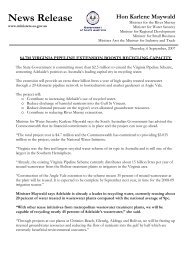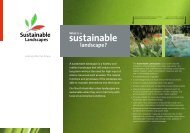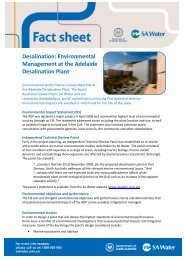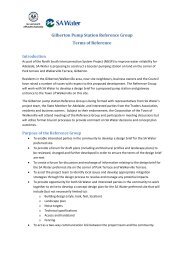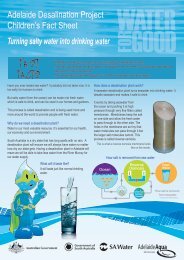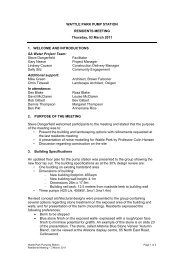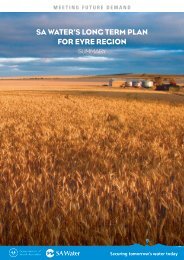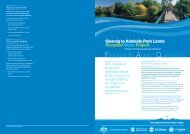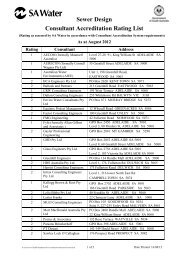Code of Practice - Irrigated Public Open Space - SA Water
Code of Practice - Irrigated Public Open Space - SA Water
Code of Practice - Irrigated Public Open Space - SA Water
Create successful ePaper yourself
Turn your PDF publications into a flip-book with our unique Google optimized e-Paper software.
3.0 POLICY & PLANNING<br />
3.1 <strong>Water</strong> use policy<br />
In order to ensure that the issue <strong>of</strong> sustainable water<br />
management is a priority for the organisation, a clear policy<br />
statement is required. This statement should outline the<br />
commitment to sustainable water use in the management <strong>of</strong><br />
<strong>Irrigated</strong> <strong>Public</strong> <strong>Open</strong> <strong>Space</strong> (IPOS). The policy should be<br />
succinct and be able to guide future decisions in relation to<br />
the provision and management <strong>of</strong> IPOS.<br />
The policy should address the planning and development <strong>of</strong><br />
new sites and should be used to assess the appropriateness<br />
<strong>of</strong> current irrigated sites.<br />
s<br />
T<br />
EXAMPLE: ISSUES TO BE ADDRESSED IN THE WATER USE POLICY<br />
• <strong>Water</strong>supply<br />
Where possible sources other than potable mains water should<br />
be identified and investigated for use on IPOS.<br />
• Environmentalandwaterqualitymanagement<br />
Steps must be taken at the planning and design stage to ensure<br />
irrigation has minimal negative affects on the surrounding<br />
environment and natural drainage systems. <strong>Water</strong> sensitive urban<br />
design principals must be considered and implemented when<br />
planning the development <strong>of</strong> IPOS.<br />
• Bestpracticeirrigationmanagement<br />
All sites irrigated should adopt the principles <strong>of</strong> best practice in<br />
regard to design, installation, maintenance and scheduling.<br />
6<br />
The objectives <strong>of</strong> this policy are to:<br />
• Achieve a balance between the provision <strong>of</strong> an amenity<br />
landscape that is aesthetically pleasing, meets the needs<br />
<strong>of</strong> the community and is economically and<br />
environmentally sustainable.<br />
• Implement the principles <strong>of</strong> water sensitive urban design<br />
to achieve integration <strong>of</strong> water cycle management into<br />
urban planning and design.<br />
• Achieve a consistent approach in the provision and<br />
development <strong>of</strong> the irrigated landscape.<br />
• Provide a clear direction and framework for irrigation<br />
and water management strategies to enable water<br />
conservation and financial savings to be achieved.<br />
The policy must be endorsed by the organisation at the<br />
highest level.<br />
• Functionalbenefit<strong>of</strong>IPOS<br />
The provision <strong>of</strong> IPOS should be based on an assessment <strong>of</strong> the<br />
functional benefit <strong>of</strong> the site. Irrigation should only be provided<br />
where there is a clear functional benefit (eg sports ground, picnic<br />
area). The area being irrigated should be the minimum required to<br />
achieve the functional objective, complimented by dry–landscape<br />
treatments. Areas with low function but high aesthetic value<br />
(eg verges, entry statements) should be restricted to water<br />
supply sources other than mains potable water.<br />
• <strong>Water</strong>efficiencymanagementplanningandreporting<br />
All sites should be covered under a water efficiency management<br />
plan and reporting process that monitors irrigation efficiency and<br />
the quality and ‘fit for purpose’ standard <strong>of</strong> the turf.



